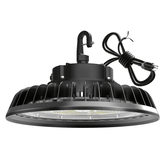WATTAGES FOR VARIOUS APPLICATIONS
Wattage is crucial for proper illumination. High Bay LED lights come in:
- High wattage for large spaces like hangars and warehouses
- Medium wattage for medium-sized venues
- Low wattage for smaller areas
Here are the lighting and wattage calculator for you:
Result:
You may have heard the phrase I bought a 150-watt light bulb at some point, but have no idea what it really means. The watt is a unit of measurement used to calculate electricity and belongs to the International System of Units (yes), it is called watt. Watt equals joules per second and the symbol is the letter W. The unit of measurement was established in memory of James Watt, a famous British engineer and mathematician who made a major contribution to the development of the steam engine.
One of the main application areas of watt is electricity, where it is used to indicate the amount of electricity consumed or produced by equipment. When we hear or read that a device has 100 watts, it is directly referring to its power. The higher the power, the higher the energy consumption. However, for ease of calculation and reading, multiples of watts are used, such as kilowatts (kW) or megawatts (MW).
How does wattage relate to our daily consumption?
If we have an 100 watt light bulb turned on for an hour, that bulb will consume the equivalent of 100 watts/hour of energy. It is important to emphasize that watts per hour (Wh) refers to the power used during a specific time interval.
One watt is equivalent to one joule per second, which means that a device that consumes one watt of power consumes the equivalent of one joule of energy per second. Continuing with the example of an 100-watt light bulb, if it stays on for one hour, it consumes a total of 360.000 joules of heat.
Formula: 100 watts (W) x 3600 seconds (s) = 360.000 joules (J)

The relationship between voltage and current and wattage
Watt (W) : They measure electricity, or the amount of energy transmitted per unit of time.
Volts (V) : represents the difference between two points of the circuit. This difference drives electrons through the conductor, creating an electric current.
Amperage (A) : is a measure of amperage, or the number of electrons flowing through a conductor in a given time.
Power (in watts) is calculated by multiplying voltage by amperes: P = V x A (where P stands for watts, V for volts, and A for amperes). The amperage value, although related to consumption, is used more for technical aspects, such as the selection of electrical components (such as cables) so that these lines do not become saturated and avoid short circuits.
In conclusion
when choosing an appliance or any electrical device, it is important to understand its watt (for calculating energy consumption) and amperage (for knowing the size and capacity of the necessary wiring). If you have any question about this, welcome to contact GGJIA sales team. Cause we have high bay lights, work lights, parking lot lights and other series, I believe we can fully meet your needs








